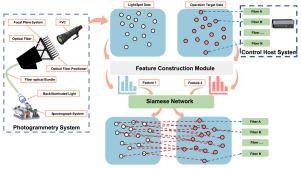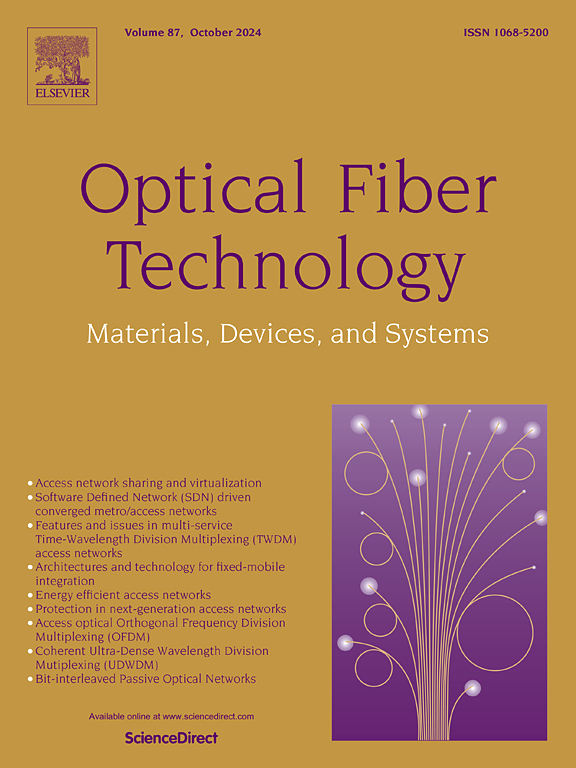基于连体网络的光纤光斑映射算法
IF 2.6
3区 计算机科学
Q2 ENGINEERING, ELECTRICAL & ELECTRONIC
引用次数: 0
摘要
集成多根光纤将星光导入望远镜摄谱仪是进行大规模多目标光谱测量中光谱分析的关键。要实现高精度的恒星光谱采集,就需要出色的光纤定位精度。目前领先的光纤定位解决方案通常采用背照式照明光纤,并依靠摄影测量系统在闭环配置中提供精确的位置反馈。虽然这些基于摄影测量的方法很有效,但它们捕获的图像缺乏区分光纤定位器(FP)和单个光点的基本特征;这尤其适用于在均匀暗背景下区分靶标光纤定位器(FFP)和科学光纤定位器(SFP)。本研究使用一维卷积神经网络作为特征提取器,分析背照式光斑图像和 FP 操作数据,以建立连体网络模型。通过比较连体网络中背照式光斑图像与运行目标数据之间的特征相似性,在每个光斑与其对应的 FP 之间建立了可靠的映射关系。当应用于大天区多目标光纤光谱望远镜(LAMOST)观测时,该方法克服了受焦平面旋转影响的FFP光斑映射的关键挑战。该方法还进一步实现了在科学光纤严重杂乱的环境中完整绘制 SFP 光斑。我们的方法为未来多目标光谱巡天仪器的光纤光斑测绘方法提供了重要参考。本文章由计算机程序翻译,如有差异,请以英文原文为准。

Light spot mapping algorithm for optical fiber based on Siamese network
The integration of multiple optical fibers for directing starlight into telescope spectrographs is pivotal for spectral analysis in expansive multitarget spectroscopic surveys. Exceptional fiber positioning accuracy is needed for the attainment of high precision in stellar spectral acquisition. Current leading optical fiber positioning solutions often utilize back-illumination illuminating fibers and rely on photogrammetry systems to provide precise position feedback in a closed-loop configuration. While these photogrammetry-based methods are effective, they capture images lacking features essential for differentiating between the fiber positioner (FP) and individual light spots; this especially applies to the differentiation between the fiducial fiber positioner (FFP) and scientific fiber positioner (SFP) against a uniformly dark background. In this study, a one-dimensional convolutional neural network is used as a feature extractor to analyze the back-illuminated light spot images and FP operation data for the development a Siamese network model. By comparing the feature similarities between the back-illuminated light spot images and the operational target data within the Siamese network, a reliable mapping is established between each light spot and its corresponding FP. When applied to Large Sky Area Multi-Object Fiber Spectroscopy Telescope (LAMOST) observations, this methodology overcomes the pivotal challenges of mapping FFP light spots affected by focal plane rotation. This method further achieves complete mapping of SFP light spots in a heavily cluttered environment of scientific fibers. Our approach provides an important reference for fiber light spot mapping methodologies in prospective multitarget spectroscopic survey instruments.
求助全文
通过发布文献求助,成功后即可免费获取论文全文。
去求助
来源期刊

Optical Fiber Technology
工程技术-电信学
CiteScore
4.80
自引率
11.10%
发文量
327
审稿时长
63 days
期刊介绍:
Innovations in optical fiber technology are revolutionizing world communications. Newly developed fiber amplifiers allow for direct transmission of high-speed signals over transcontinental distances without the need for electronic regeneration. Optical fibers find new applications in data processing. The impact of fiber materials, devices, and systems on communications in the coming decades will create an abundance of primary literature and the need for up-to-date reviews.
Optical Fiber Technology: Materials, Devices, and Systems is a new cutting-edge journal designed to fill a need in this rapidly evolving field for speedy publication of regular length papers. Both theoretical and experimental papers on fiber materials, devices, and system performance evaluation and measurements are eligible, with emphasis on practical applications.
 求助内容:
求助内容: 应助结果提醒方式:
应助结果提醒方式:


